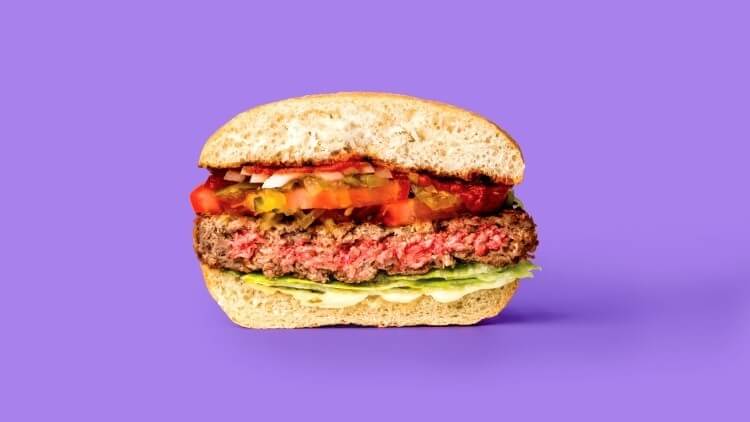The food industry, and in particular livestock, remains unsustainable in many categories across climate, supply, nutrition, and accessibility. This has become more evident during the pandemic as meat producers grappled with food and worker safety issues. In May, Tyson Foods was linked to almost 5,000 cases of coronavirus in its meat-processing plants across 15 states, causing a spike in meat prices (Business Insider). The largest meat processing plants like Smithfield Foods, JBS, and Perdue farms were also affected by plant closures. Though they have implemented new safety measures and are now nearly back to pre-pandemic levels, players like Impossible Foods and Beyond Meat have thrived during the pandemic. Grocery store sales of vegan meat rose by 264% in the nine weeks ending May 2 (WSJ). For Impossible, the top ingredient is soy, and relies on machinery run by a few essential employees for production.
Below are some additional data points on challenges in the traditional meat industry:
- Growing Population — The world population is estimated to reach 10 billion people by 2050. This amounts to an additional 2 billion people to feed on top of the 3 billion people who are currently malnourished. Meeting protein demands, an essential nutrient in our diet which constitutes roughly 10–35% of daily calories, will be crucial. Demand for meat has nearly tripled in the developing world for the last four decades while egg consumption has increased sevenfold. At this rate, experts say crop production needs to double to feed livestock.
- Labor Shortage — The agricultural workforce in the US has been shrinking. The reported number of self-employed and family farmworkers in the last couple of decades has steadily declined while the average age of operators nears 60. Farmers often point to shortage of labor as the greatest limiting factor on farms.
- Land Usage — A 2018 study calculated that meat, aquaculture, eggs, and dairy use about 83% of the world’s farmland while providing only 37% of humanity’s protein consumption (Reason). In the US, over 33% of U.S. land is used for pasture — the largest land-use type. If all meat, milk, egg, and fish production were replaced using generated rather than grown foods, that could restore 781 million acres that were allocated to livestock feed, or about 41% of the total land area of the contiguous United States!
- Climate Impact — Agriculture is the largest cause of global environmental change. Food production contributes approximately 30% of global greenhouse gas emissions, and the livestock sector alone represents almost half (15%) of these emissions. In the US alone, beef accounts for 36% of all food-related GHG emissions. Livestock also uses 70% of freshwater, along with animal excrement and agricultural runoff polluting nearly one-third of rivers in the US. Besides meat, about 60% of the world fish stocks to be fully fished or overfished (FAO).
- Food Safety — Livestock production is often perceived as a messy business involving the management of animal waste and slaughter. There are many opportunities along the supply chain for food to become contaminated or spoiled. The use of antibiotics as veterinary medicines and growth promoters is also seeing its drawbacks as drug resistance grows.
New Protein Methods Replacing Livestock
Almost ten thousand years ago, humans domesticated plants and animals to eat. We controlled the production of food from wheat to cows, altering evolution to select the best traits and conditions. We also learned to manipulate micro-organisms through fermentation to create bread, cheese, and alcohol. Today, we appear to be on the verge of a new phase in food production by actually creating micro-organisms. Currently, we already produce plant natural products like vanilla, sweeteners, vitamins, and cannaboids; however, this could extend to creating proteins from all plant and animal sources.
One key process that creates micro-organisms is precision fermentation (PF). PF has been proven through the production of insulin, growth hormones, and more recently, collagen. Looking forward, PF will help improve plant-based products and create cell-based meat, as many of these products have already completely disrupted existing markets.
Take cheese as an example. Cheese was initially made from extracting rennet, an enzyme also known as chymosin, through the stomachs of newborn calfs. Other methods include plant-derived chymosin (like artichokes) or microbial chymosin from molds (Source). The preferred method of creating rennet is by fermentation. In this process, chymosin is extracted from an animal’s stomach cells then implanted into yeast cultures. Today, it is estimated that over 90% of commercially produced cheese made in the United States is produced by fermentation-produced chymosin. Although the FDA does not require cheesemakers to specify what type of rennet they use, fermentation-produced rennet has proven cost-effective, reliable, and widely used.
Similarly, startups are working to create proteins that would reduce the need for animal-based products. Perfect Dayhas created casein and whey proteins, found in real dairy milk, by fermenting microflora. As applications begin to expand into animal meat, cows will begin to become displaced as a key source. Creating micro-organisms rather than extracting from macro-organisms will pave way for more accessible and cheaper protein options.
Meat Replacement Methods and Sources
- Cultured / In Vitro Meat — Similar to in-vitro fertilization, in-vitro meat involves taking muscle tissue from an animal into cell culture. This technique is used in regenerative medicine to repair human tissues and organs. However, recreating meat such as steak is a challenge given the complex structure of muscle tissue and capillaries. Researchers rely on obtaining fetal bovine serum, the liquid component of blood from calf’s fetus, to help cells divide. Given how expensive the serum is, companies are working to develop plant-based sources for growth factors (McGill). In addition to finding plant-based serum as a growth medium, other explorations include types of starter cells to use (Future Food).
- Plant Substitutes — The most popular and straightforward replacement for meat has been swapping it out completely for plants to find a similar taste and texture. Vegetables and legumes that have high protein content include mushrooms, tofu, beans, lentils, chickpeas, and jackfruit. Proteins are also directly being extracted from peas, soy, and wheat. Impossible Foods found a way to extract heme from plants, which is a molecule that gives blood red color and is abundant in animal tissue but is also a culprit in the health defects of red meat. Other popular replacements include seitan, also known as wheat gluten, which is a simple and cost-effective way to make vegetarian meat. Tempeh, fermented from soya beans with a Rhizopus mold, also contains high protein content.
- Fungi — A new area of research includes startups addressing that need at scale by naturally fermenting mycelium, the vegetative fungus that produces mushrooms. Companies cultivate their own mycelium in large tanks, adding sugar and other nutrients to help it grow. Ecovative Designclaims its product needs 9–12 days of growth, while traditional chicken farming would take 12 weeks in addition to using natural resources and creating waste. Unlike most vegetable-based alternatives, which use plant protein isolates to mimic the minced texture of ground meat, mycelium’s long, branching fibers are well suited to approximate the texture of a muscle.
- Insects — Insects have also received considerable attention because they can turn food waste into body mass, contributing to a more circular agricultural economy. Additionally, crickets contain more bioavailable nutrients and protein, comprising 69% of protein while beef only has 29% (Source). Brands likeEXOhave created more mainstream products like protein powder and bars to consume.
Benefits to Alternative Sources of Protein
- Health — The American Institute of Cancer Research suggests limiting red meat (beef, pork, veal, lamb, goat) to three portions/week or 12–18 oz cooked weight as well as to limit processed meats (sausages, hot dogs, bacon, ham). Consuming a balanced vegetarian or vegan diet has consistently been shown to be nutritionally adequate in providing sufficient amounts of essential amino acids (NCBI). In addition, balancing diets by other meat alternatives has overall positive effects on health, with a maximum predicted reduction in mortality rates of 5–7% for fiber-rich beans, peas and mycoprotein. Although there isn’t a prolific amount of research studying vegetarian versus meat-based diets, current studies show that there is little no negligible difference between those who get their protein from plants versus animals. Exercise performance for athletes also does not appear different between dietary groups across different types of activities. However, more research is needed on how certain foods and diets can affect the body.
- Personalization and Production — With the help of precision fermentation, there will be an overwhelming range of possibilities to produce foods that can be tailored to a consumer’s allergic and nutritional needs. Producing food will also be more predictable given decentralized and resilient production. There will be less dependency on consolidated players, geography, climate, and foreign exchange rates. Meat alternatives will also be less vulnerable to contamination and spoilage.
- Lower Cost — The cost of precision fermentation is being driven ever lower by a steep decline in the cost of precision biology. The cost of producing a single molecule by PF has fallen from $1m/kg in 2000 to about $100/kg today and will continue to decline in a couple of years (RethinkX). Precision fermentation could be on the verge of outcompeting animal agriculture in scalability and efficiency.
Drawbacks on Alternative Meat
- Heme on Health — Studies have shown that consumption of more beef increases the individual risk associated mortality by about 1.5%, mainly due to heme, which is also present in the Impossible Burger. Heme produced by cooking soy leghemoglobin. While most people in middle and high‑income countries get adequate iron from a varied diet, some individuals can suffer iron deficiency, which meat (though also other food types) can help to remedy.
- Refined Meat Alternatives are Processed — Ultra-processed foods are agreed to be health risks. Studies have shown that heavily processed foods often contain high levels of added sugar, sodium, fat. They are also stripped of their basic nutrients, faster to digest which causes lower calorie burn; and contain additives and artificial ingredients (Health and Safety Fund). John Mackey, CEO of whole foods who is vegan, claims he is not sold on health benefits of plant-based meats. Looking at Beyond Meat’s website, ingredients for its plant-based patties include water, pea protein isolate, expeller-pressed canola oil, refined coconut oil, rice protein and other natural flavors, including apple extract and beet juice extract. Ingredients for Impossible Foods’ burger include water, soy protein concentrate, coconut oil, sunflower oil, potato protein, soy leghemoglobin, and other natural flavors. It seems that even refined plant-based meat alternatives can have health drawbacks as well depending on ingredients and consumption.
Companies Pioneering the Space

Personally, I’m most excited about R&D discoveries in cell-based animal meat, seafood alternatives, and dairy.
- Memphis Meats, a Berkeley-based, Series B startup founded in 2015, has raised $181M to create cell-based meat. The startup aims to decrease the cost of lab-grown meat in order to compete with commercial meat down to $5 a pound. Its original meat cost $18,000 a pound due to the expensive feed for cells, but by January 2018, it cost $2,400 per pound. The lines between food and biotech begin to blur as the company announced its intention to use CRISPR in developing products.
- Wild Type, a Berkeley-based, Series A startup founded in 2016, has raised $16M to date to create cell-based salmon. The company plans to initially release minced salmon and lox and work its way up to filets, with the goal of pricing salmon at $7 to $8 per pound. Last year, they debuted a Portland dinner event that used the product in six different ways, from ceviche to salmon rolls.
In the future, it seems the source of meat will likely matter less if we are able to recreate the protein profile in a tasty way— a highly challenging and long term process. In the near term, however, introducing new meat and dairy alternatives will still make meaningful advances in diversifying food sources and providing nutritional, scalable options globally.





























